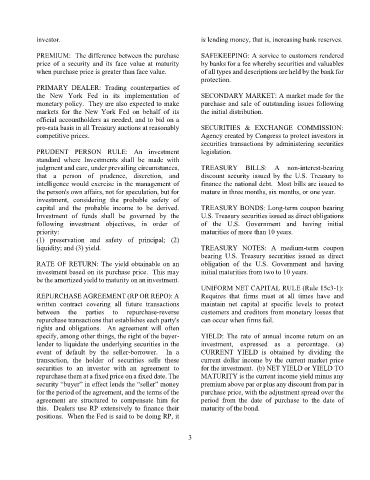Page 569 - Bedford-FY24-25 Budget
P. 569
investor. is lending money, that is, increasing bank reserves.
PREMIUM: The difference between the purchase SAFEKEEPING: A service to customers rendered
price of a security and its face value at maturity by banks for a fee whereby securities and valuables
when purchase price is greater than face value. of all types and descriptions are held by the bank for
protection.
PRIMARY DEALER: Trading counterparties of
the New York Fed in its implementation of SECONDARY MARKET: A market made for the
monetary policy. They are also expected to make purchase and sale of outstanding issues following
markets for the New York Fed on behalf of its the initial distribution.
official accountholders as needed, and to bid on a
pro-rata basis in all Treasury auctions at reasonably SECURITIES & EXCHANGE COMMISSION:
competitive prices. Agency created by Congress to protect investors in
securities transactions by administering securities
PRUDENT PERSON RULE: An investment legislation.
standard where Investments shall be made with
judgment and care, under prevailing circumstances, TREASURY BILLS: A non-interest-bearing
that a person of prudence, discretion, and discount security issued by the U.S. Treasury to
intelligence would exercise in the management of finance the national debt. Most bills are issued to
the person's own affairs, not for speculation, but for mature in three months, six months, or one year.
investment, considering the probable safety of
capital and the probable income to be derived. TREASURY BONDS: Long-term coupon bearing
Investment of funds shall be governed by the U.S. Treasury securities issued as direct obligations
following investment objectives, in order of of the U.S. Government and having initial
priority: maturities of more than 10 years.
(1) preservation and safety of principal; (2)
liquidity; and (3) yield. TREASURY NOTES: A medium-term coupon
bearing U.S. Treasury securities issued as direct
RATE OF RETURN: The yield obtainable on an obligation of the U.S. Government and having
investment based on its purchase price. This may initial maturities from two to 10 years.
be the amortized yield to maturity on an investment.
UNIFORM NET CAPITAL RULE (Rule 15c3-1):
REPURCHASE AGREEMENT (RP OR REPO): A Requires that firms must at all times have and
written contract covering all future transactions maintain net capital at specific levels to protect
between the parties to repurchase-reverse customers and creditors from monetary losses that
repurchase transactions that establishes each party's can occur when firms fail.
rights and obligations. An agreement will often
specify, among other things, the right of the buyer- YIELD: The rate of annual income return on an
lender to liquidate the underlying securities in the investment, expressed as a percentage. (a)
event of default by the seller-borrower. In a CURRENT YIELD is obtained by dividing the
transaction, the holder of securities sells these current dollar income by the current market price
securities to an investor with an agreement to for the investment. (b) NET YIELD or YIELD TO
repurchase them at a fixed price on a fixed date. The MATURITY is the current income yield minus any
security “buyer” in effect lends the “seller” money premium above par or plus any discount from par in
for the period of the agreement, and the terms of the purchase price, with the adjustment spread over the
agreement are structured to compensate him for period from the date of purchase to the date of
this. Dealers use RP extensively to finance their maturity of the bond.
positions. When the Fed is said to be doing RP, it
3

